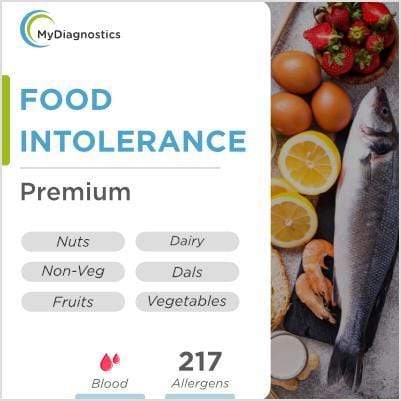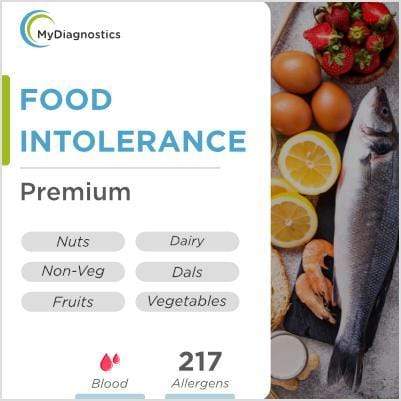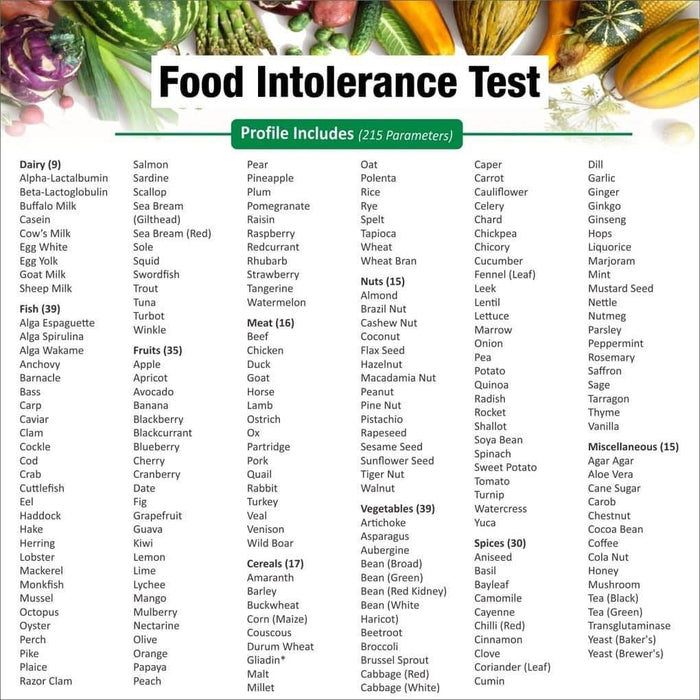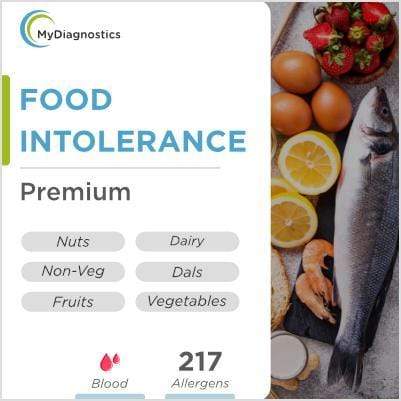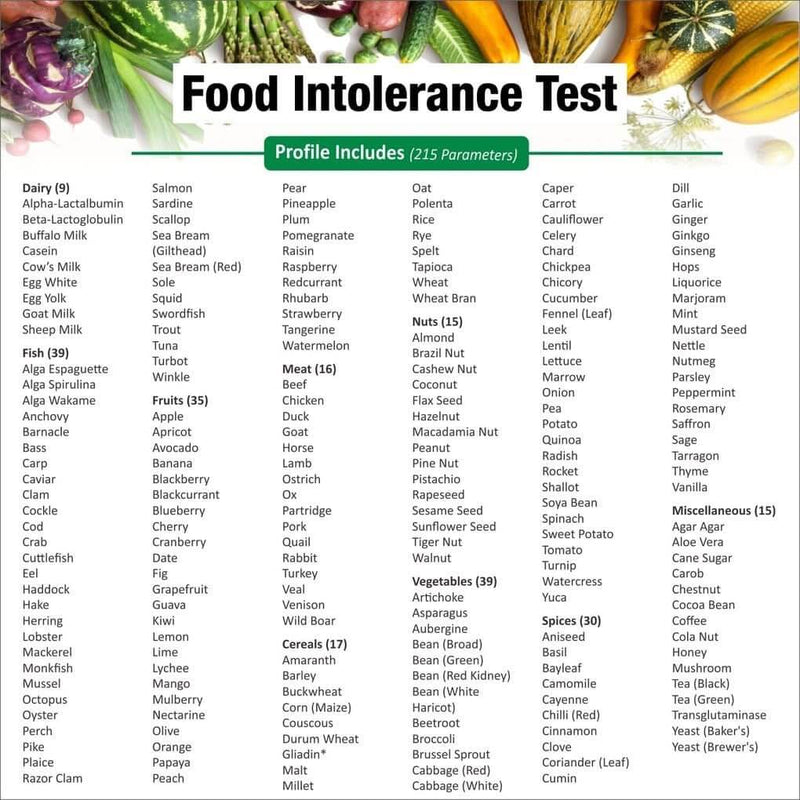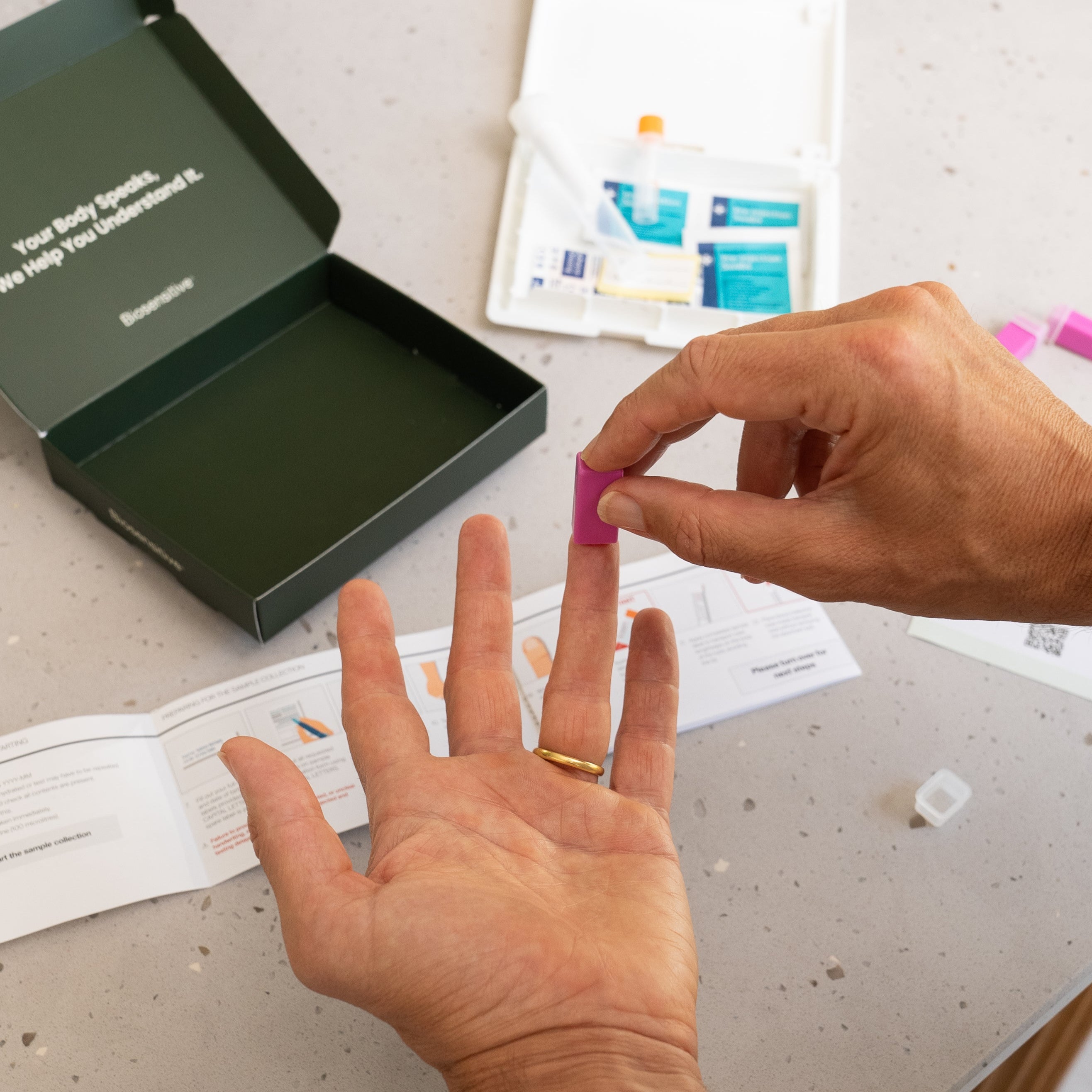Premium Food Intolerance Test (IgG test based)
Test Parameters

About the IgG Test - Food Intolerance
A food intolerance diagnostic test will identify the foods that your body cannot digest, which is particularly beneficial for patients. The food allergies to foods vary since they induce ige mediated allergies and an IgE-mediated immune response that may result in severe reactions. Food intolerances happen due to a lack of enzymes or slower reactions of the immune system, which would usually be related to IgG antibodies.
You can get our Premium Food Intolerance Blood Test across major cities in India. Our testing coverage includes Bangalore, Hyderabad, Chennai, Mumbai, Pune, Ahmedabad, Delhi, Gurgaon, Noida, Ghaziabad, Faridabad, Jaipur, Lucknow, Kolkata, and Chandigarh. You can easily order an at-home test in these cities and get your report delivered directly to your email address.

What is a Food Intolerance Test?
The food intolerance test is a diagnostic tool and method that determines foods or ingredients that your body finds difficult to digest or it has an adverse reaction. Unlike food allergies, which activate the immune system, resulting in immediate, serious reactions, food intolerance is typically caused by digestive issues or a lack of enzymes. It has milder and slower symptoms.
Key Points about Food Intolerance Tests
-
Purpose: The test is applied to identify foods which can trigger digestive distress, bloating, headaches, fatigue and skin or other non-allergic symptoms.
-
Mechanism: Immune response is measured by many tests, such as the level of IgG antibody to certain foods. Others check enzyme activity e.g. lactase in lactose intolerance or eliminate diets can be used to determine triggers.
Difference Between Food Allergy and Intolerance
Food allergy is a dangerous immune system-mediated reaction to foods. It can cause severe or life-threatening symptoms like anaphylaxis. Food intolerance, on the other hand, is a digestive system issue that causes less severe symptoms like bloating, gas, and stomach pain after consuming specific foods.
|
Aspect |
Food Allergy |
Food Intolerance |
|
Immune Response |
IgE antibodies (immediate) |
IgG antibodies (delayed) |
|
Reaction Time |
Within minutes |
Hours to days |
|
Severity |
Can be life-threatening (anaphylaxis) |
Usually digestive discomfort, fatigue, inflammation |
|
Example |
Peanut allergy |
Lactose intolerance, gluten sensitivity |

https://www.mayoclinic.org/diseases-conditions/food-allergy/expert-answers/food-allergy/faq-20058538
Test Overview
Food intolerance refers to the body's difficulty in digesting or processing certain foods. Unlike food allergies, food intolerance develops gradually, causes digestive or systematic symptoms like gas, bloating, fatigue, and skin issues.
Our IgG based Premium Food Intolerance Test analyzes vegetarian and non-vegetarian foods and food allergens , providing you with a clear picture of your allergies.
IGG Food Sensitivity Test
This is also a blood test that is used to estimate the concentrations of Immunoglobulin G (IgG) antibodies that your body produces in reaction to certain foods. In contrast to the food allergy where the IgE antibodies are involved causing immediate, occasionally serious symptoms. IgG mediated food sensitivities typically manifest hours to days after a particular food is consumed, leading to chronic symptoms . The common symptoms can be bloating, tiredness, headaches, skin issues or digestive issues.
Gluten Intolerance Test
A gluten intolerance test is done to check the level of digestion of gluten and other intolerant foods in your body to help identify specific foods that may cause issues, which is a protein present in wheat, barley and rye. The sensitivity to gluten is different to both autoimmune disorder-celiac disease and IgE-driven allergy to wheat.
Lactose Intolerance Test
This test helps determine whether your body can digest lactose, the natural sugar found in milk and other dairy products, through a blood sample collection. Lactose intolerance happens when the small intestine secretes insufficient amounts of the enzyme lactase, which splits lactose into galactose and glucose to be absorbed. Failure to decompose lactose may lead to bloating, gas and diarrhea as well as abdominal cramps, necessitating treatment .
Methods of Food Intolerance Blood Tests
Food intolerance blood tests usually measure the body’s immune response or enzyme activity in relation to specific foods. The main methods are: other tests.
IgG Antibody Test (Most Common)
This food intolerance test measures the IgG antibodies against specific foods in the blood. For this test a blood sample is taken and analyzed using ELISA to check reactions against 200+ foods. The test procedure are;
-
A healthcare professional draws blood sample from the vein.
-
The blood is collected into a serum-separating tube.
-
The blood sample is centrifuged to separate the serum.
-
The serum is used for testing against the large panel of food proteins.
-
Then food extracts are coated on a microtiter plate.
-
The patient's serum is added.
-
A detection antibody is added to bind the IgG-food complex.
-
A substrate is added, and the enzyme reaction produces a measurable color change.
-
The color intensity is measured with a spectrophotometer. Stronger color ensures higher IgG antibody level.
IgG4 Subclass Testing
This food intolerance test detects IgG antibodies in the blood. The main purpose of the test is to differentiate between food allergy and food intolerance. For this test most labs use ELISA (Enzyme-Linked Immunosorbent Assay) or ImmunoCAP methods.
-
A healthcare professional takes a small blood sample from the vein or arm.
-
The blood is centrifuged to separate serum.
-
The serum is stored and prepared for analysis.
-
The patient's serum is exposed to food protein panels or allergens coated on a plate.
-
If IgG4 antibodies are present, they will bind to the antigens.
-
A detection system will produce a measurable color reaction.
-
The color intensity corresponds to the IgG4 antibody amount.
Fructose or Other Sugar Malabsorption Blood Tests
This food intolerance test is similar to the lactose test, but with fructose or other sugars. It is rarely used for breath testing but sometimes done in clinical settings. For this test, the patient fasts for at least 8 to 12 hours before the test. The test procedures are;
-
A baseline blood glucose is measured by drawing blood from vein.
-
The patient drinks a specific amount of sugar (25-50 g fructose) for being tested.
-
Blood sample is taken at intervals.
-
Glucose levels are measured in every level.
-
If the glucose levels rise significantly, the sugar gets absorbed normally.
-
If the glucose levels fail to rise, it suggests malabsorption.
Celiac Disease Blood Test (Gluten Intolerance / Sensitivity)
This test measures antibodies like tTG-IgA (tissue transglutaminase) and EMA. Also, detects autoimmune gluten intolerance. This food intolerance test is different from non-celiac gluten sensitivity, which has no reliable blood test. For the test, the patient must be on a gluten-containing diet for at least 6 to 8 weeks before the test. If gluten is neglected before the test, the antibodies may drop, that may lead to false negatives.
-
A blood sample is drawn from the arm.
-
Serum is separated and sent for antibody testing.
-
tTG and IgA antibodies are mainly checked in this test.
Benefits of the Test
A food intolerance diagnostic tool test has a number of valuable advantages to health and well-being in general, especially in distinguishing food allergies. Among its main benefits is the fact that it helps to detect certain foods that cause unpleasant symptoms like bloating, gas, diarrhea, headaches, fatigue or skin issues and avoid trial-and-error dieting and waste time and guesses.
Prevents Long-Term Digestive Damage
One of the biggest advantages of getting tested for food intolerances, specifically gluten intolerance, is the ability to detect the condition early and prevent long term intestinal damage. Being constipated, experiencing diarrhea or bloating. many people are not aware that it is gluten that causes the problem in the first place. When you recognize that gluten is the culprit among various food items , eliminating it in your diet will be able to heal your gut and limit these digestive issues significantly.
Reduces Fatigue and Nutrient Deficiencies
Absorption of essential nutrients like iron, folate, vitamin B12 among other important vitamins can be impaired by gluten sensitivity. Because of this, individuals can have chronic fatigue, lack of energy and even food intolerance situations. With the detection of gluten intolerance, people will be able to switch over to a gluten-free diet that is rich in protein , which enhances better nutrient absorption and subsequently restores energy levels.
Supports a Personalized Diet Plan
A gluten intolerance test provides a clear indication of how the test works and whether gluten is the culprit or not, eliminating guesswork. It makes it easier to adhere to a gluten-free diet and ensures a balanced intake of protein, vitamins, and minerals. An individualized plan enhances overall health and prevents unwarranted limitations.
Improves Immunity and Reduces Inflammation
Low-grade inflammation is associated with gluten intolerance that may suppress the immune system, leading to skin rashes, joint pain and frequent infections, which can also be a symptom of irritable bowel syndrome. Through gluten sensitivity diagnosis, individuals can eliminate inflammatory triggers, which enhances immunity, eliminates skin issues and promotes good health.
How it Works
A food intolerance test or an IgG-based gluten sensitivity test is an easy, convenient and very informative thing to come by, and you can download report for your records . The test is aimed at identifying food intake that could be the cause of digestive problems, fatigue or inflammation, and provides a detailed report . The detailed description of each of the steps is presented below.
Sample Collection
The first step in an intolerance blood test is sample collection, specifically collecting a blood sample. This can be done in two ways:
-
Lab-based collection: A small vial of blood is drawn from a vein by a trained phlebotomist at a diagnostic lab. This method is highly accurate and preferred for full panels covering hundreds of foods.
-
At-home collection kits: For convenience, many labs provide finger-prick kits that allow you to collect a small blood sample at home. Once collected, the sample is sealed and sent to the lab for analysis.
Lab Analysis
Once the sample is received in the lab, a sophisticated immunoassay is performed on the sample to determine the presence of IgG antibodies against certain foods.
-
This is the essence of the blood test of food sensitivity. The test is done to quantify the levels of antibodies of more than 100-200 regular foods such as grains, dairy foods, meats, vegetables, fruits, nuts, etc.
-
Your IgG is high and this indicates that your immune system is responding to some foods. This may indicate delayed food sensitivities, which may be resulting in digestive complications or inflammatory issues.
It normally takes several days in lab analysis. It entails the accurate quantification of the levels of antibodies in order to ensure accurate results.
Report Generation
This is analyzed and you are given a detailed report and given a ranking of your sensitivities as being high, moderate or low. The report has a full list of foods that were tested and the degree of reaction that you had on them. It also provides customized nutritional suggestions to decrease inflammation, enhance digestion as well as increase energy. Also within will be the tips of dealing with food sensitivities and the recommendation of other safe foods that your body can tolerate. These practical lessons help in making it easier to develop a diet plan that prioritizes your particular sensitivities.
Pricing & Packages
In India, the price of a food intolerance test depends on the type of test, the number of foods, and the laboratory. A variety of options are provided by most diagnostic providers: specific panels as well as full tests based on a full meal. Selecting the correct package provides you with the correct results and does not exceeding your budget. At MyDiagnostics, the cost for food intolerance is INR 7,499. Here, you will get the best medical services from experienced healthcare professionals.
Popular Test Packages
|
Test Type |
Foods Covered |
Average Cost (INR) |
|
IgG Food Sensitivity Test |
100–200 foods (veg & non-veg) |
₹7,000 – ₹15,000 |
|
Gluten Intolerance Test |
Wheat/gluten panel |
₹2,000 – ₹5,000 |
|
Lactose Intolerance Test |
Milk & dairy panel |
₹2,000 – ₹4,000 |
|
Full Food Intolerance Panel |
Comprehensive veg & non-veg, 100–200+ items |
₹10,000 – ₹18,000 |
Key Points About Pricing
-
Combo Packages: Some labs offer discounts if you choose gluten + lactose + IgG panels together, making it more economical.
-
Home Collection Kits: At-home sample collection may slightly increase the cost due to shipping and processing.
-
Lab Accreditation: Prices can vary depending on the reputation and accreditation of the lab, but accredited labs provide more reliable and clinically validated results.
Tips for Choosing the Right Package
-
Start with specific testing in case you have an inkling that you are intolerant to a specific intolerance, e.g. gluten or lactose.
-
Select a complete food panel when you experience ongoing digestive issues or unexplainable sleepiness.
-
Never doubt the credentials of the lab and ensure that the customer care is friendly to ensure the testing process is smooth.
Who Should Take This Test
A food intolerance test would assist patients and anyone, especially those with a family history and having unexplained health or digestive complications, much like an allergy test . Being aware of which foods bother you will help in better digestion, enhance the level of energy and enhance well-being in general, potentially requiring medical attention . The following is a breakdown of the people who can benefit the most.
People with Digestive Issues
Should you frequently experience bloating, gas, diarrhea, constipation, or stomach cramps, then a food intolerance test may identify the foods that cause you to feel like that, potentially preventing severe allergic reactions similar to food allergy testing . Most of the digestive problems are caused by delayed immune response towards some foods and this is not always immediate after the food is eaten.
Individuals Experiencing Fatigue or Low Energy
Food sensitivities may have been the root cause of you experiencing chronic fatigue, brain fog or low energy despite having enough sleep. You would improve the absorption of nutrients and automatically replace the energy levels by avoiding the triggers and identifying them to kick start your energy levels.
Suspected Gluten or Lactose Intolerance
Individuals experiencing digestive discomfort following the consumption of wheat or dairy items ought to be put to the test. By establishing whether the culprit is gluten or lactose through a single test and identify specific foods causing adverse reactions, they will be able to embrace a safer diet.
Athletes and Fitness Enthusiasts
Individuals who work-out a great deal or adhere to rigorous diets are the beneficiaries of food intolerance tests. Such tests are useful to maximize nutrient intake from different foods and decrease inflammation to enhance performance and recovery.
Individuals with Skin or Inflammatory Issues
Sensitivities to foods may provoke skin complications, pains in the joints or mild inflammation. Testing will allow identifying the factors that are hidden and the symptoms may be minimized with time.
Those Seeking Personalized Diet Plans
To create a balanced and efficient meal program, intolerance test results can be used to make your food choices and ensure better health, weight loss or disease prevention.

